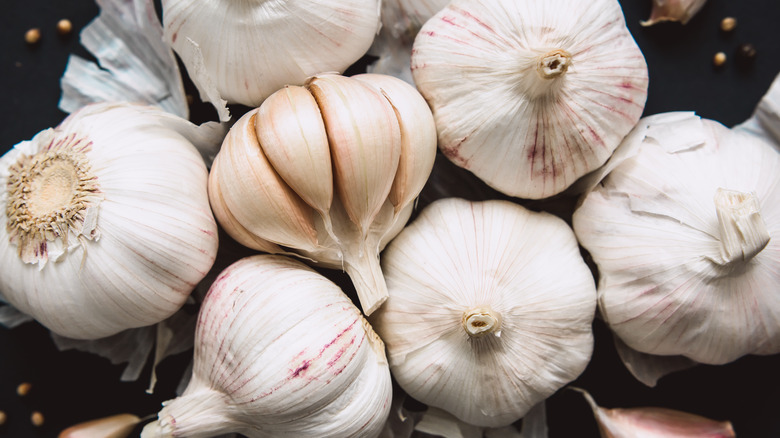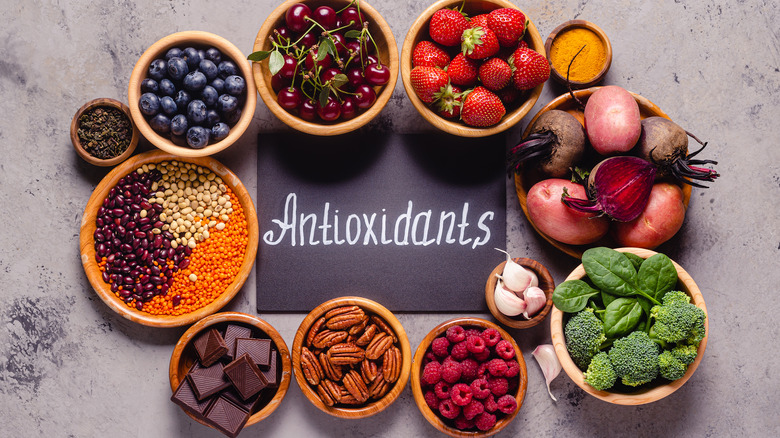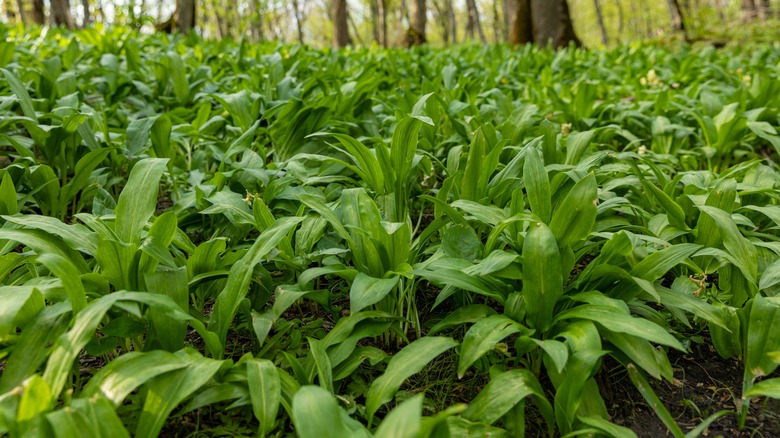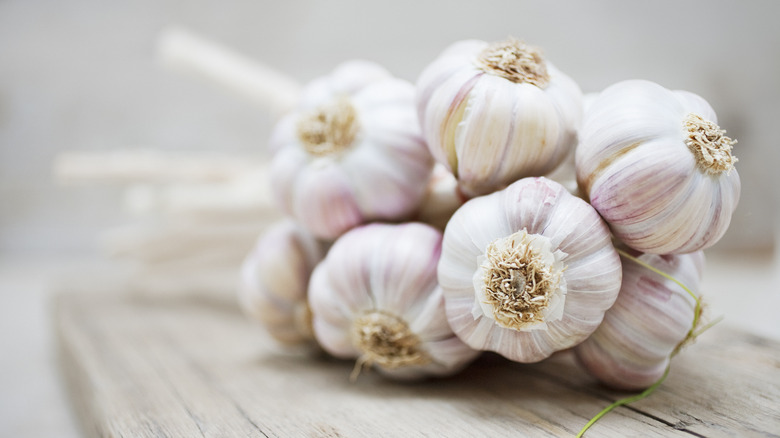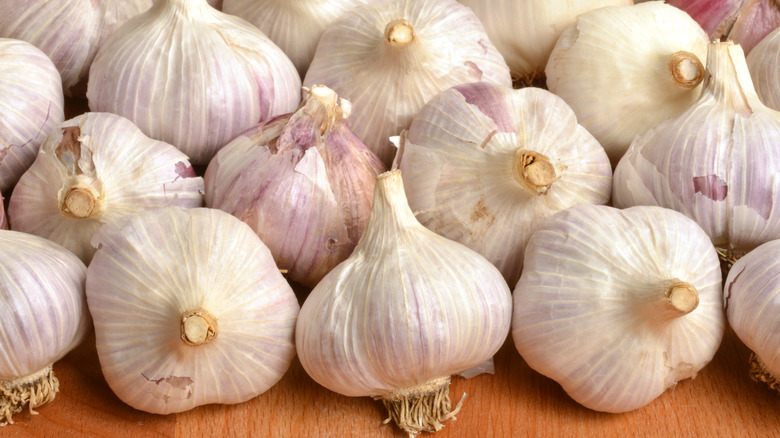Myths About Garlic You Thought Were True
Human beings have cultivated garlic since the very beginning of recorded history. The ancient Egyptians fed garlic to the day workers constructing the great pyramids, believing it would keep them healthy and strong. In Ancient China, the little bulb's effectiveness as a cure-all for diarrhea and intestinal worms was common knowledge. Across the Indian subcontinent, garlic was believed to cure arthritis, while over in Europe, it was said to ward off the unwelcome attention of all things that go bump in the night.
Today, garlic is best known in the culinary world for its intense aroma and ability to elevate dishes via a powerful punch of flavor. Famously absent from many lunchtime menu items (ancient Greeks wishing to enter the temple of Cybele were forced to pass a garlic breath test before being allowed in), garlic's ubiquity has helped spawn a whole slew of old wives' tales, folklore, and outright falsehoods about its much-lauded properties.
So, listed below, in no particular order, you'll find some good old-fashioned debunking of some "facts" about garlic that, upon closer reflection, really are nothing of the sort. First up, though, is an important disclaimer.
Garlic really is a superfood
Garlic is really good for you. One reason so many myths surround the pungent little vegetable stems from some of its truly remarkable properties.
Nutritionally, it certainly qualifies as a superfood; it is rich in magnesium — an essential component of literally hundreds of metabolic processes — and high in vitamin B6, which is associated with brain health and the production of red blood cells. It's also loaded with vitamin C, low in fat, and an excellent source of iron and potassium, two essential ingredients that promote growth and help move nutrients around the body.
Some of the false facts listed below are actually a collection of half-truths, exaggerations, or genuine misconceptions, many of which stem from well-meaning advice. Beneath every outlandish claim lies a kernel of truth, and garlic — stripped of its mystical properties and Instagram hyperbole — remains a fantastic, healthy, and delicious addition to a balanced diet.
Myth: Garlic is needed for detoxing
A quick Google search of garlic's health benefits reveals page after page, extolling its virtues as an essential component of anyone's detox routine. Supplements and salads are included alongside raw garlic cleanses, broths, foul-sounding tinctures, wild garlic pesto, and garlic-scented spa treatments. It all sounds very compelling, yet it comes with a rather important caveat: Your body doesn't need detoxing.
Anatomy students will recall that our body is designed to detoxify itself via a rather magnificent organ, most commonly referred to as the liver. This 'hepatic system' makes up the second largest organ in the human body after the skin and works tirelessly to remove unwanted toxins from the body. Its very presence renders the need for a detox regime somewhat truth-adjacent.
Still, it stands to reason that diet plays a role in maintaining healthy liver function. A liver packed full of too much sugar or pickled in alcohol cannot function properly and, in the worst-case scenario, allows toxins to build to dangerous levels.
Thankfully, garlic can help with some of the heavy lifting here. According to a study in Avicenna Journal of Phytomedicine, regular consumption of garlic helps protect liver cells from overuse of over-the-counter painkillers such as acetaminophen. Its raw form has been shown to reduce the risk of fatty liver disease in men, according to another study in Diabetes, Metabolic Syndrome and Obesity.
Myth: Garlic-hating vampires are real
Just about anyone you care to ask would be able to list the basic protections one can wield in the face of a sudden and unexpected vampire attack: the crucifix, the sun's light, a sprinkle or two of holy water, and, ah yes, garlic! Vampires hate garlic, right? As is so often the case, the answer to that question is a hard maybe. Vampire myths are culturally universal, and as with all such lore, it's sometimes difficult to find a definitive origin point. One promising candidate for the progenesis of the vampire myth stems from the medical condition of porphyria.
Per Biology Dictionary, porphyria is a type of anemia caused by a deficit in an enzyme related to heme synthesis, an essential molecule that contains iron and acts as a precursor to hemoglobin. Those affected by the condition often experience hypersensitivity to light and receding gums, an aesthetic that, back in the day, might have been mistaken for a pair of shiny fangs.
Whilst drinking people's blood could theoretically have provided some relief from porphyria-related symptoms, it seems unlikely that anyone would have made the connection in the days before medical science identified the cause of the condition. Still, certain compounds contained within garlic induce a heme-reducing enzyme that would noticeably exacerbate the symptoms of porphyria, leading to a somewhat surprising conclusion. While actual vampires remain confined to the silver screen, the suspected vampires of yesteryear quite possibly did hate garlic.
Myth: Garlic helps you lose weight
Talk of superfoods, vitamins, and minerals inevitably leads to a discussion of any given food's potential dietary benefits. From celebrity diet tips to articles extolling garlic's purported ability to help people shed pounds if — and only if — it is consumed raw, the weaponization of garlic in the never-ending battle of the bulge respects no borders.
Some claims, however, appear to be more suspect than others. For one, garlic contains a compound known as allicin, and according to a paper published in the American Journal of Hypertension, allicin does indeed suppress appetite. Still, as anyone who has continued to plow through an entire packet of Oreos past the point of satiation can attest, there is more to weight loss than simply stopping when you are full.
A study on weight loss published in the Journal of Advanced Biomedical Research observed a reduction in body weight among patients after 15 weeks of garlic supplementation, offering an apparent slam-dunk to the idea that garlic is an effective weight-loss tool. However, the study also conceded that further in-depth study was required before making any definitive claims.
What's left, then, are the usual caveats. While garlic is low in fat and contains many helpful health benefits, a spoonful of raw garlic a day is unlikely to help you squeeze into that favorite pair of jeans that no longer fit. Effective weight loss generally requires adherence to a calorie-controlled diet and an active lifestyle.
False: Garlic is just garlic
As far as superfoods packed with vitamins, minerals, and alleged healing properties go, garlic packs a relatively puny punch. Cheap and nutritious, though it might be, garlic is just garlic, right? It's that vegetable we all know and love so much that we use it in prodigious quantities when we're in the mood for something quick and tasty. Well, yes and no.
Garlic belongs to the genus Allium, which includes some 600 species of plants, including leeks, onions, and chives. There are two primary varieties of garlic: the hardneck and the softneck. The hardneck possesses a stem — known as a scape — that worms its way to the surface and sticks out of the ground as the bulb grows. The softneck has no scape, and since it is easier to grow, most of the garlic bought in supermarkets is of this type. Hundreds of varieties, local specialties, and rare breeds lie within these two broad categories.
Thankfully, according to the Garlic Seed Foundation, budding allium connoisseurs need only concern themselves with 10 species. Even within these 10 common cultivars, only two principal characteristics remain. According to Garlic Gardening, hardneck garlic offers a broad spectrum of flavors that starkly contrast with the somewhat muted, homogenous profiles of their softneck brethren. From a culinary perspective, choosing the perfect garlic to compliment the perfect dish is not so much a minefield as an exercise in personal taste, preference, and sense of adventure.
Myth: Garlic treats ear infections
Putting garlic into an ear to help cure an inner ear infection is near the top of the long list of home remedies that should never be attempted. This myth seems to have originated—as so many myths do—from certain facts about garlic's antimicrobial efficacy.
According to Frontiers in Micrology, garlic's antibacterial properties are located within the allium compound — the same compound that gives the genus its name and the bulb its signature smell. In tests, applications of aqueous garlic extract demonstrated antibacterial action against several pathogens dangerous to humans, such as E. coli and salmonella.
Further studies — such as a 2020 study published in Trends in Food Science and Technology — suggested that garlic might also possess antiviral properties that help fight infections such as hepatitis, flu, and warts. That said, since the infection is likely behind your eardrum, sticking a garlic clove in your ear isn't the answer, because, per Dr. Roy Benaroch on Consultant 360, it couldn't reach the site of infection (and because sticking anything that far into your ear is not a good idea, anyway).
Substituting garlic oil is also useless here since the eardrum is deliberately non-porous. Fluid leaking into the middle ear could only occur via a perforated eardrum; throwing some garlic at that condition is most inadvisable. So, while many conditions benefit from topical antibacterial ointments, the middle ear isn't one of them.
Myth: Mosquitoes hate garlic
Few things can ruin a day in the country with as much surety as the suddenly incessant buzzing of humanity's oldest nemesis—the mosquito. According to Timothy Wingard — author of The Mosquito: A Human History of Our Deadliest Predator — the mosquito is responsible for the premature death of over half of every human being who has ever lived. Attempts to destroy the pest during the 1950s — with the hope of eradicating Malaria — proved unsuccessful, and subsequent efforts hit similar roadblocks.
Two main theories exist regarding garlic's potential prophylactic nature as it pertains to bloodsucking creatures. The first notion is that it might somehow taint the blood itself. According to a report published in Medical and Veterinary Entomology, mosquitoes were happy to consume the blood of those who had dined on garlic and those who abstained in equal measure. So, while garlic might add a little zing to an otherwise unseasoned blood feast, mosquitoes don't seem to mind the taste.
The second theory draws conclusions from one of garlic's better-known properties: its pungent aroma. Once again, allicin is in the spotlight: it contains what are known as volatile organic sulfur compounds, or VOSCs for short. Puncturing the skin of the garlic clove releases the compounds, and once ingested or handled, the smell lingers for quite some time. Sadly, according to Mosquito Reviews, topical application of garlic does not make for an effective deterrent.
False: There is no such thing as too much garlic
Everyone has experienced the sudden, inexplicable, and irrational temptation to double the amount of garlic suggested in any given recipe. Science may never know where such an urge comes from, but it does lead to the question of how much garlic is too much garlic?
Firstly, as with most things, moderation is key. While studies have shown that garlic can benefit the liver, ingesting too much can also damage the organ. According to a report published in Tropical Gastroenterology, garlic's exact toxicity level is unknown. Still, it seems to be relatively low, considering there are no official guidelines on how much garlic a person should or should not consume. Not that the health warnings end there.
Infusing oil with garlic can lead to spectacular results as long as appropriate precautions are taken. According to the United States Department of Agriculture, homemade garlic oil should be stored in a fridge set to 40 F or lower and consumed within seven days to prevent the risk of exposure to botulism.
In a similar vein, too much garlic can cause more than just stinky breath. There are several side effects of garlic, including gastrointestinal discomfort, heartburn, and diarrhea. Garlic is also a known trigger for people with irritable bowel syndrome, and it is high on the list of foods to avoid for those susceptible to GERD or acid reflux.
Myth: Garlic can treat acne
Acne has long been the bane of teenage existence, and some adults still reporting symptoms in their 40s, it's little wonder that a number of home remedies have popped up from time to time.
While the exact origins of this myth are difficult to pin down, allicin's medicinal properties seem like the most obvious culprit. Garlic's general reputation as a medicinal aid has almost certainly encouraged experimentation with topical applications over the centuries. Meanwhile, its proven track record as an antibacterial agent and noted effectiveness against psoriasis — as suggested by the British Journal of Pharmacology — lends credence to the idea that a dab of garlic on an angry-looking pimple might be the cure-all society has been looking for.
Alas, things are rarely that simple. According to a study published in the Current Health Sciences Journal, garlic acted as an exacerbating factor; topical applications of garlic made acne worse, not better. Things get even worse when switching from garlic's raw form to more concentrated, naturopathic, over-the-counter remedies. In a study published in the Annals of Burns and Fire Disasters, researchers noted the potential pitfalls of using garlic, likening its effect to a chemical burn. The Indian Dermatology Online Journal concurred, stating that, "The degree of burn is directly proportional to the quantity of garlic, duration of exposure, the presence of pre-existing dermatoses, and skin sensitivity."
Myth: Garlic cures colds
There are more homemade cold remedies than secret menu items at Taco Bell, so it's hardly surprising that people advocate using garlic to stave off seasonal sniffles.
The official line on treating a cold is known to everyone: Stay hydrated, rest, and treat symptoms with over-the-counter decongestants and painkillers. Still, the exquisite misery of a five-day head cold encourages experimentation with common tips, tricks, and family tradition ways of blunting the worst a cold can throw at us. Many of these — such as eating chicken soup and drinking vitamin C-rich orange juice — help with the hydration part of the equation. Other suggestions often prove more esoteric. For example, the familiar trope of feeding a cold and starving a fever has been widely debunked.
The case for garlic, however, is still up for debate. According to the Cochrane Database of Systematic Reviews, the traditional belief that garlic possesses cold-fighting properties is not entirely without merit. However, their research did not suggest that garlic impacts the progress of the rhinovirus itself. Instead, it indicated that consuming garlic helps prevent catching a cold in the first place. Put simply, subjects given garlic supplements for three months caught fewer colds than those given a placebo.
So, what seems like an open-and-shut case for garlic supplements and their efficacy against colds requires a slight tempering. Garlic isn't going to help you power through a cold, but regular intake might well stop you from getting one in the first place.
Myth: Garlic does not bring down fevers
Most of the myths listed above are relatively harmless. Since garlic is a healthy, low-calorie vegetable packed with vitamins and minerals and a flavor profile well above its weight, adding a little garlic to the diet is generally good. True, garlic has occasional side effects, but for the most part, as long as people consume it in moderation, it benefits their overall health.
Indeed, most of the issues associated with garlic consumption arise not from eating it but from its use as a topical treatment. Fighting acne or warding away blood-sucking pests is one thing; using garlic to break a child's fever is quite another.
The myth that rubbing raw garlic on an infant's skin can bring down a fever is not only factually incorrect; it's also dangerous. A report in the Journal of Paediatric Emergency Care detailed the severity of a burn received by a 15-month-old child after her mother rubbed raw garlic on the infant's feet in an attempt to bring down a fever. The Indian Dermatology Online Journal also warned against the use of garlic as a home remedy, detailing the plight of a 60-year-old woman suffering from self-inflicted chemical burns after applying garlic paste to her thigh. In short, there is no evidence to support the efficacy of topical garlic as an antidote to fever, and there are plenty of examples of it just making things worse, so this is one myth that is best left in the trashcan of history.
